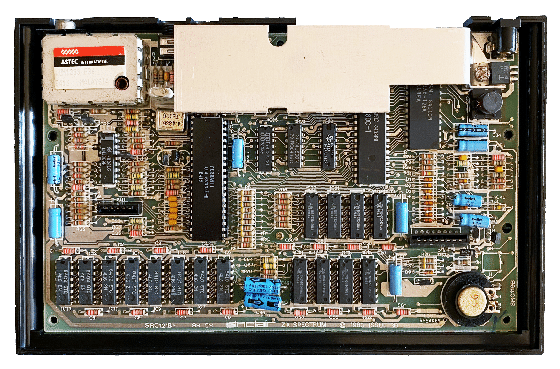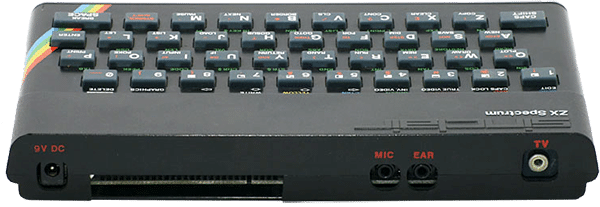

Production: 1982
OS: Sinclair Basic
ZX Spectrum
Sinclair after the ZX80 and ZX81 models also sold in kit form, launched the ZX Spectrum keeping much of the system adopted on the previous models.
This computer was sold already assembled and no longer in kit form, with an improved keyboard compared to the predecessors, but still a membrane keyboard and had a buzer to generate sounds always using the Z80 processor.
The name Spectrum was chosen to differentiate it from previous products that were only in black and white, this computer had to have a "spectrum" of colors and hence its name.
Below is the classic screen with the "k" prompt for entering commands.

A prerogative of the Sinclair keyboard was to have the Basic commands already mapped on the keys, obviously the first models had a horrible keyboard to program and to limit the numerous pressures they thought of already entering the commands by pressing only one key.
The Spectrum has a more functional keyboard with rubber keys but uses the same system as the previous models, what makes it difficult to use is having to go and find the command you need and often having to use more than one function key !! . OK, if you get carried away then it's not a big tragedy ..
The line followed by Sinclair was to keep the cost of the products low and on this model it worked perfectly ..
We have a computer with a minimal and pleasant line but above all very small, a hardware not very powerful but exploited all, just like the thought of Clive Sinclair. The colors were 8, a little 'think a little, but thanks to the possibility of being able to manage 1 level of brightness (except on black) you get to 15 shades of color.
The Spectrum did not have the possibility to manage the Sprites and therefore the games are more complicated to program and above all color artifacts occur when the character passes over an area of the background with another color. The sound is limited to the generation of a square wave and performed by a buzer, but you have noticed that there are no joystick ports !!.
Clive's thought was to put on the market a machine used for teaching, study and work ... in short, not for playing! being able to have a computer that was cheap to play also contributed a lot to its sale.
The cost was low, lower than the Commodore 64 and many chose this system for this too, which worried Commodore a lot, seeing the market that had cornered and ran for cover trying to create a line that had to be low cost to wipe out. Sinclair, the 264 series, which for various reasons did not go as expected and turned out to be a great flop.

If you notice the only video output it is equipped with is RF, no composite audio / video connectors, followed by the connectors for the recorder, the expansion port and power supply. Don't worry, if nowadays you want to use the Spectrum with the analog signal just make a small modification and that's it.
In the end it was not Commodore that closed its doors to Sinclair, unfortunately the too many resources invested in various projects put the company in crisis which was later acquired by Amstrad which continued to produce some models using the same name.
In my opinion this is the most successful computer from Sinclair, it is small, has a very simple and beautiful line, it is economical and functional.
Later they presented other variants such as the plus version with plastic keys and no longer rubber and later the 128K which was the last product of the Sinclair house before the acquisition by Amstrad.
We cannot also speak of the Sinclair QL which was designed for professional and non-playful use, but which made several mistakes to get it out in a hurry, before the Apple Macintosh. Among the most serious problems of the QL was the hardware that was not developed enough to make it stable, many pieces needed an external ROM. Even the software was not free from bugs and above all the unfortunate choice of Microdrives, so loved by Sinclair. other Microdrives.
The computer was made with the only ability to manage 8 colors to discourage any game development, to keep it in the market it was intended for. The end was inevitable, in 1985-86 an 8-bit computer with the release of other much more powerful machines (Atari ST, Amiga, Macintosh) was struggling to survive, the market for which it was designed was nothing but an illusion and the IBM Computer soon established itself as a work and home machine, setting a definitive standard.


